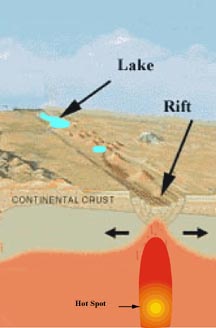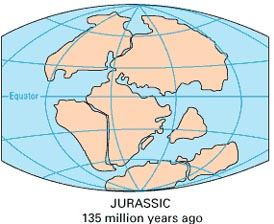
Rifts are areas of active spreading. Midocean ridges are areas of active seafloor spreading where
new oceanic crust is added to divergent plate boundaries.
However, all rifts are not presently in ocean basins. Young new rifts can occur on land on
the continents and can cause a continent to split apart (hence they are also divergent plate boundaries).
At first, the continental rocks are rifted
into a valley, and then the rift will deepen. Sometimes lakes form in the rift.
The Atlantic Ocean was formed by one such rift. Evidence of this ancient rift valley remains in the Newark Group sediments and igneous rocks including the Wachung Mountains and Palisades Sill of New York and New Jersey. The Newark Group sediments are continental deposits of sandstone and shale that filled in a portion of the rift valley system as it widened. The Wachungs are basalt lava flows that broke through the thinning continental crust . At that time, during the Triassic Period more than 200 million years ago, North America was connected to Africa and Europe, forming the northern portion of the supercontinent Pangea. During the Triassic and the next geologic period, the Jurassic, the ocean started to flood in and a Proto-Atlantic Ocean began to form, with North America on one side and Europe and Africa on the other. New seafloor was added at the rift (which would now be considered the Midatlantic Ridge). The rift broke up Pangea.
Today a similar process is rifting East Africa apart. The Somalian plate to the east is being rifted away from the Nubian plate to the west.




How rifts actually start is not entirely clear; perhaps, as one theory suggests they start where a hot spot of volcanic activity due to a mantle plume (a hot, torch-like jet of heat rises from near the mantle-core boundary) cuts through the crust. If the cut is effected in an area of plate tension, a new divergent boundary is formed. There is evidence that not all rifts successfully form new divergent boundaries, and ancient failed rifts such as the Midcontinent Rift of the United States and the failed arms of rifts such as the North Sea of Europe are known.
At present some scientists believe that the region of Nevada, eastern California (including Death Valley), Arizona, and New Mexico, called the Basin and Range physiographic province (a complex region of fault-block structures formed by stretching of a thin crust), may be a new early rift undergoing tensional stress. Proving that the California lifestyle isn't completely compatible with the rest of the country!
![]() Click here to see a reconstruction of Pangea beginning to break up 195 MYA
Click here to see a reconstruction of Pangea beginning to break up 195 MYA
![]() Click here to see the Atlantic form as Pangea continues breaking up 152 MYA
Click here to see the Atlantic form as Pangea continues breaking up 152 MYA
Click here to go back to Chapter 1